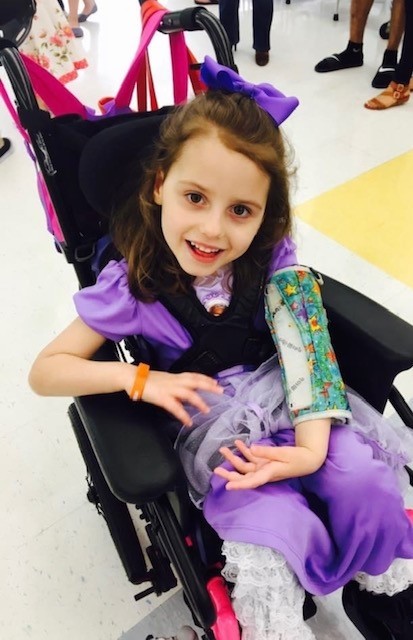Topics
Mother of patient at Texas Children’s Hospital shares her daughter’s story to raise awareness for Rett syndrome

Baby Hannah had a healthy birth. Her mother, Denay, still recalls her first drive home from the hospital in Monroe, Louisiana, where Hannah was born — her feelings of love and joy, her feelings of hope and excitement for the future.
“Hannah was a happy, healthy child,” said Denay. “For the next twelve months, we had no idea anything was wrong. She hit all her milestones. Around her first birthday, however, she started to regress.”
Hannah’s speech — having evolved from the happy, infant babblings of childhood to the joy of first words — suddenly halted in its development. So did her movement: her first steps, her coordination.
“After six weeks of therapy — speech, physical and OT therapy — she wasn’t making any progress,” said Denay. “In fact, she was continuing to regress. Ultimately, we ended up at Texas Children’s Hospital, where she was diagnosed.”
Hannah was diagnosed with Rett syndrome when she was 21 months old. A happy, warm-hearted girl with a beautiful smile, Hannah is now 11, and her mother is thrilled to report that she is still thriving. She requires a wheelchair and a feeding tube. She struggles with seizures, GI issues and scoliosis. But she is the same happy girl who left the hospital with her mother back in 2012.
Denay is sharing Hannah’s story to spread awareness about Rett Syndrome.
Rett syndrome
Rett syndrome is a rare genetic neurological disorder that primarily affects girls — about 1 in 10,000 worldwide — causing a progressive loss of motor skills and language. Most cases of Rett syndrome are caused by spontaneous mutations in the X-linked gene called methyl-CpG-binding 2 (MECP2); very few are caused by familial inheritance.
Females have two copies of the MECP2 gene (one in each of their X-chromosomes), which means that most girls with MECP2 mutations develop normally, like Hannah, and then start showing signs of regression — half of their cells have a healthy copy and half have a mutant copy of the gene.
Eventually, Rett syndrome leads to severe impairments that affect a child’s ability to speak, walk, eat and breathe easily. Some patients suffer from irregular heartbeats, sleep disturbances and scoliosis (sideways curvature of the spine). Most experience seizures at some point in their lives. A hallmark of Rett syndrome is near-constant repetitive hand movements — hand wringing.
Since males do not have a second set of X chromosomes, they will have the mutant gene in every cell and so the consequences of MECP2 mutations will be much more severe — most die during infancy or early childhood.
Currently, there is no cure for Rett syndrome.
The Blue Bird Circle Rett Center at Texas Children’s
Denay and her family now live in Lubbock, Texas, but they bring Hannah to Houston for treatment.
“Here in Lubbock, not many people know about Rett syndrome, not even doctors,” said Denay. “That’s why we bring Hannah to Texas Children’s — even though it’s a ten-hour drive. I want my daughter to be treated by the best, and to have the best opportunities, and those are at Texas Children’s Hospital. Here, people are knowledgeable about Rett, and they have the passion and commitment to pursue research and bring treatments for this condition. Plus, the Rett clinic is really good at working with the other clinics to make sure we can schedule all the treatments Hannah needs, so we do back-to-back appointments for a day and a half to get everything done.”
Since 1985, Texas Children’s has been home to one of the nation’s largest resources for families of children with Rett syndrome. The Blue Bird Circle Rett Center specializes in the diagnosis, treatment and follow-up care of children with Rett syndrome. The Rett Center also supports education and research through the Jan and Dan Duncan Neurological Research Institute (Duncan NRI).
Dr. Huda Zoghbi, founding director of the Duncan NRI at Texas Children’s and Professor at Baylor College of Medicine, is widely renowned for her groundbreaking research on the discovery of mutations in the MECP2 gene as the cause of Rett syndrome in 1999. Over the last few decades, pioneering research from her team at the Duncan NRI has led to significant progress in understanding the biology of this rare disorder. Dr. Zoghbi’s research has laid the groundwork for multiple breakthroughs in Rett syndrome and the field is now at the cusp of many promising therapies that are undergoing rigorous clinical testing.
Dr. Bernhard Suter, medical director of the Blue Bird Circle Rett Center at Texas Children’s and Associate Professor of Pediatrics at Baylor College of Medicine, is a world-renowned expert in Rett syndrome — he is the doctor who originally diagnosed and treated Hannah — and he is hopeful for patients like Hannah.
“Our strong hope is that research being done here will pave the way for promising new treatments in the near future, which will offer the potential for significant impact on this terrible disorder,” said Dr. Suter.
Raising awareness for Rett syndrome
Denay is the state representative for the Texas chapter of the International Rett Syndrome Foundation, and she often speaks to families whose children are recently diagnosed with Rett syndrome.
“The one thing I always tell them is to find community,” said Denay. “Hope for new treatments is exciting, but it’s only part of the solution. People need a village of support. I encourage people to reach out and find those groups that can help. Use the resources that Texas Children’s makes available. Get involved. We’re all in this together, and we can all make a difference when we do our part.”
To that end, Denay has published two children’s books that are based on Hannah.
“That’s one way that I work on advocacy and spreading awareness,” said Denay. “Kids are interested in Hannah; they want to know why she’s in a wheelchair. But if they are told, ‘Don’t talk to her,’ then that’s a negative experience for both parties.”
She continued, “I wanted to explain to kids that we all have our part to play; we can all help. We can be kind and inclusive, and we can all go on adventures whether we use two wheels or two feet. Hannah’s wheelchair gives her the freedom to seek adventure and to live a full life.”
Learn more about the Blue Bird Circle Rett Center at Texas Children’s




